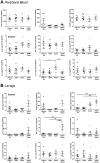Early life allergen and air pollutant exposures alter longitudinal blood immune profiles in infant rhesus monkeys
- PMID: 28529118
- PMCID: PMC5535809
- DOI: 10.1016/j.taap.2017.05.006
Early life allergen and air pollutant exposures alter longitudinal blood immune profiles in infant rhesus monkeys
Abstract
Early life is a critical period for the progressive establishment of immunity in response to environmental stimuli; the impact of airborne challenges on this process is not well defined. In a longitudinal fashion, we determined the effect of episodic house dust mite (HDM) aerosol and ozone inhalation, both separately and combined, on peripheral blood immune cell phenotypes and cytokine expression from 4 to 25weeks of age in an infant rhesus monkey model of childhood development. Immune profiles in peripheral blood were compared with lung lavage at 25weeks of age. Independent of exposure, peripheral blood cell counts fluctuated with chronologic age of animals, while IFNγ and IL-4 mRNA levels increased over time in a linear fashion. At 12weeks of age, total WBC, lymphocyte numbers, FoxP3 mRNA and IL-12 mRNA were dramatically reduced relative to earlier time points, but increased to a steady state with age. Exposure effects were observed for monocyte numbers, as well as CCR3, FoxP3, and IL-12 mRNA levels in peripheral blood. Significant differences in cell surface marker and cytokine expression were detected following in vitro HDM or PMA/ionomycin stimulation of PBMC isolated from animals exposed to either HDM or ozone. Lavage revealed a mixed immune phenotype of FoxP3, IFNγ and eosinophilia in association with combined HDM plus ozone exposure, which was not observed in blood. Collectively, our findings show that airborne challenges during postnatal development elicit measureable cell and cytokine changes in peripheral blood over time, but exposure-induced immune profiles are not mirrored in the lung.
Keywords: Cytokine; House dust mite; Infant; Ozone; Peripheral blood.
Copyright © 2017 Elsevier Inc. All rights reserved.
Figures







Similar articles
-
Ozone and allergen exposure during postnatal development alters the frequency and airway distribution of CD25+ cells in infant rhesus monkeys.Toxicol Appl Pharmacol. 2009 Apr 1;236(1):39-48. doi: 10.1016/j.taap.2008.12.031. Epub 2009 Feb 7. Toxicol Appl Pharmacol. 2009. PMID: 19371618 Free PMC article.
-
Repeated episodes of ozone inhalation amplifies the effects of allergen sensitization and inhalation on airway immune and structural development in Rhesus monkeys.Toxicol Appl Pharmacol. 2003 Aug 15;191(1):74-85. doi: 10.1016/s0041-008x(03)00218-7. Toxicol Appl Pharmacol. 2003. PMID: 12915105
-
Organized lymphatic tissue (BALT) in lungs of rhesus monkeys after air pollutant exposure.Anat Rec (Hoboken). 2020 Nov;303(11):2766-2773. doi: 10.1002/ar.24456. Epub 2020 Jul 14. Anat Rec (Hoboken). 2020. PMID: 32445535 Free PMC article. Review.
-
Immune and airway effects of house dust mite aeroallergen exposures during postnatal development of the infant rhesus monkey.Clin Exp Allergy. 2003 Dec;33(12):1686-94. doi: 10.1111/j.1365-2222.2003.01812.x. Clin Exp Allergy. 2003. PMID: 14656356
-
Assessing the health effects and risks associated with children's inhalation exposures--asthma and allergy.J Toxicol Environ Health A. 2008;71(3):196-207. doi: 10.1080/15287390701597897. J Toxicol Environ Health A. 2008. PMID: 18097945 Review.
Cited by
-
Ozone-induced enhancement of airway hyperreactivity in rhesus macaques: Effects of antioxidant treatment.J Allergy Clin Immunol. 2020 Jan;145(1):312-323. doi: 10.1016/j.jaci.2019.08.034. Epub 2019 Oct 15. J Allergy Clin Immunol. 2020. PMID: 31627909 Free PMC article.
References
-
- Asher MI, Montefort S, Bjorksten B, Lai CK, Strachan DP, Weiland SK, Williams H Group, I.P.T.S. Worldwide time trends in the prevalence of symptoms of asthma, allergic rhinoconjunctivitis, and eczema in childhood: ISAAC Phases One and Three repeat multicountry cross-sectional surveys. Lancet. 2006;368:733–743. - PubMed
-
- Barker DJP. Maternal nutrition, fetal nutrition, and disease in later life. Nutrition. 1997;13:807–813. - PubMed
-
- Beck R, Lam-Po-Tang PR. Comparison of cord blood and adult blood lymphocyte normal ranges: a possible explanation for decreased severity of graft versus host disease after cord blood transplantation. Immunology and cell biology. 1994;72:440–444. - PubMed
-
- Bernstein JA, Alexis N, Barnes C, Bernstein IL, Bernstein JA, Nel A, Peden D, Diaz-Sanchez D, Tarlo SM, Williams PB. Health effects of air pollution. J Allergy Clin Immunol. 2004;114:1116–1123. - PubMed
Publication types
MeSH terms
Substances
Grants and funding
LinkOut - more resources
Full Text Sources
Other Literature Sources
Medical

